Bathed in the light of a slowly-setting sun, Adrian Madlock stands outside a former Ukranian Orthodox church in Lincoln’s South Bottoms neighborhood. The Byzantine cross hanging next to the building’s double doors and a small wooden tower topped by the same cross hint at the modest building’s past life.
The neighborhood, settled in the late 19th century by Germans from Russia (there’s a small museum in their honor), is bound by the A Street overpass to the south, a smattering of industrial buildings to the north, train tracks to the east and Salt Creek to the west. While the neighboring Near South bustles with the activity of a small city’s urban center, life in South Bottoms churns with the satisfied languor of a stubbornly unchanged little village.
Some streets remain unpaved. There are no gas stations or stores. A massive vacant lot, dotted with dandelion heads, is a space for neighbors to convene and drink cheap beer on the tailgates of rusty pickup trucks.
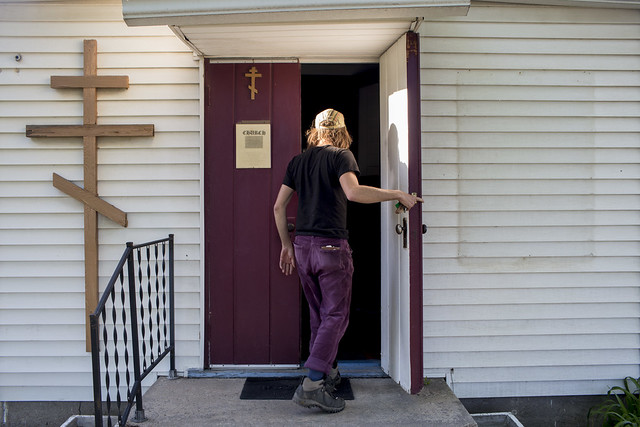
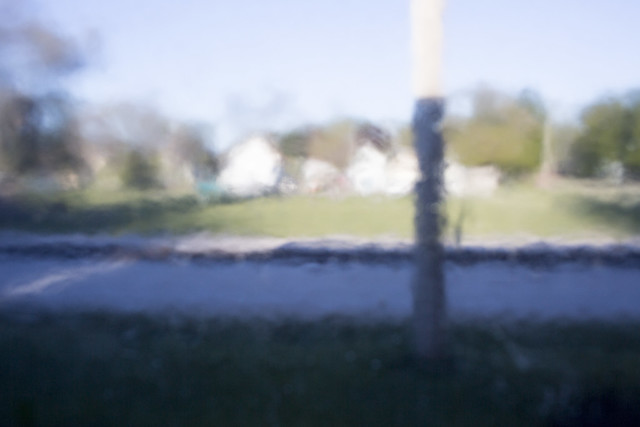
In front of the white vinyl-sided church, Madlock, a Lincoln hip-hop artist who performs as Sleep Sinatra, greets fellow hip-hop acts one-by-one as they arrive at the unassuming building for GOODGOSPEL Vol. 2, a monthly showcase he curates.
Recently the space has been repurposed from a house of worship to a music venue by Margot Erlandson and Dustin Rymph. These days it’s simply called Church and there, thanks to GOODGOSPEL, Lincoln’s hip-hop scene has begun to find a badly needed and perhaps unlikely home.
In an interview before the showcase, Madlock says Lincoln has the foundation for an enterprising hip-hop community but it needed a space to grow. When Erlandson and Rymph began booking shows for Church, he saw the opportunity. GOODGOSPEL Vol. 1 was Church’s first official show.
“It’s a way for us to network in person and bounce ideas off one another and show support for one another and let people know they mess with that sound you’re creating,” Madlock says.
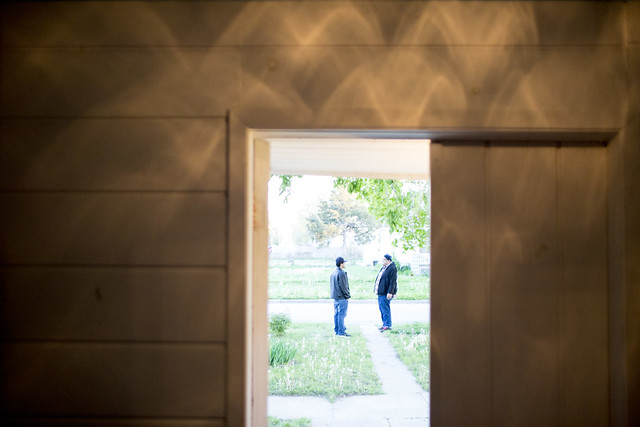

He speaks about the scene with a parental love — deep appreciation and a desire to see it blossom. Madlock has been working in Lincoln for nearly a decade, enough time to watch dozens of talented artists come and go. Hopefully with a robust monthly headquarters, he’ll begin to see more come than go.
That headquarters was built when Erlandson and Rymph saw an ad for the building’s rental on Craigslist. It’s an idea they had often talked about, turning a church into a venue space, but neither expected it would actually come to fruition.
“All the other churches in town would cost more to rent,” Rymph says. “And it’s not often that there’s a church that’s just been abandoned.”
They signed the lease and Rymph moved into the building’s next-door parsonage, which dwarfs Church itself and for the most part conveniently acts as a barrier protecting against potential noise complaints from neighbors. It’s worth noting that on April 30, police officers did appear at Church ostensibly following a noise complaint.
A month into its run and Church’s calendar is already staying full with touring and local acts — largely playing the types of basement grunge, scuzzy indie rock and anti-folk familiar to Lincoln DIY spaces. Erlandson says she spends sometimes 30 hours a week responding to booking requests among other responsibilities associated with running the venue.
“We’ve both been running house-show-houses and Margot’s been booking for years,” Rymph says. “I’ve always wanted to start a weirdo, off-the-beaten path venue.”
The idea behind Church and do-it-yourselves spaces like it is one of changing where the power lies in artistic transactions. In a typical bar venue, decisions are made financially. Bands are often booked to drive alcohol sales.
“For good reason, a bar doesn’t want to have a Saturday night with people playing experimental music,” Rymph says. “But there are a lot of people who appreciate it.”


With a relatively low rent and virtually no staffing needs, Church is free to make room for the weird, the experimental and the underappreciated. It necessarily becomes a space for alternative voices.
“There’s a need for places where acts and genres who don’t get a lot of play in the downtown scene can go,” Rymph says. “The downtown scene is cool but it can definitely be a male-dominated space, a white-dominated space. That’s something to fight of course.”
As example, each Church show so far has had women on its bill, Erlandson says.
Dominated by people of color and with only the occasional-or-less show in Lincoln’s traditional venues, the city’s often-overlooked hip-hop community has been a natural fit for Church’s ethos. It’s provided the risk-free place to connect and exchange ideas Madlock says they need to solidify a reputation as hard-working, supportive artists.
At GOODGOSPEL Vol. 2, there’s a fraternal enthusiasm among the artists and friends compounded by Church’s tiny nave where 20 people feels like a packed house. Here, performers Cameron Golden Lion, Verze, Hakim and DJ Phantom Janitor aren’t a rare breed of Lincoln artist who would likely be the outsider on any Duffy’s (for example) bill. They are outsiders-made-insiders.
Madlock kicks off the showcase with an acapella verse in his impassioned-slacker delivery. In the far corner, artist Dwight Edward Brown III paints a tribute to Prince one day after the artist’s death. At the prior showcase he made a tribute to Phife Dawg shortly after his death. Brown says he’s hoping he won’t have to do another tribute next month.

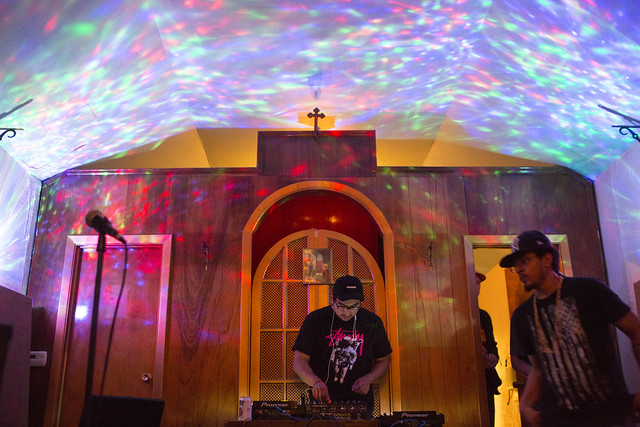
There are a few threads connecting Lincoln hip-hop artists. Perhaps the most significant is the distinction between hip-hop and, as Madlock puts it, “mainstream rap sound.” By his definition, that rap sound, which does exist here, is more solitary to the music itself. Hip-hop, on the other hand, tends to be an artistic culture characterized by a loose set of shared ideas.
Aesthetically that means old school boom-bap beats, often heady production and a spiritual alignment with superhero and anime-obsessed nerd culture. Verze, for instance, also goes by Black Kakarot, a Dragon Ball Z reference. In one verse, Cameron drops the names Tony Stark, Clark Kent and Harvey Dent. The next Sleep Sinatra album takes its title, Vibranium, from Marvel Comics.
Politically, Lincoln’s hip-hop scene is, generally, a potent blend of self-celebration and the nature of contemporary blackness. Vibranium, in addition to providing the material for Captain America’s shield, is inextricably connected to Wakanda, the fictional African country from which the Black Panther hails.
“Vibranium has an afrofuturist sound in comparison to my previous projects,” Madlock says. “I’m speaking a lot about police brutality, Black Lives Matter movement, racial profiling.”
These themes are repeated across the work of many Nebraska hip-hop acts.
The ideas and values that bind GOODGOSPEL’s circle of friends and collaborators are, to some extent, still being worked out. The show isn’t without bumps: there are some hiccups smoothly transitioning from one track to the next and each artist’s performance style is still being honed and tested. But if anything, these blemishes only reinforce the showcase’s importance as a staging ground for the hip hop community. After all, as Erlandson and Rymph seem to understand, the freedom to refine an approach is one of the most basic functions of a DIY venue.
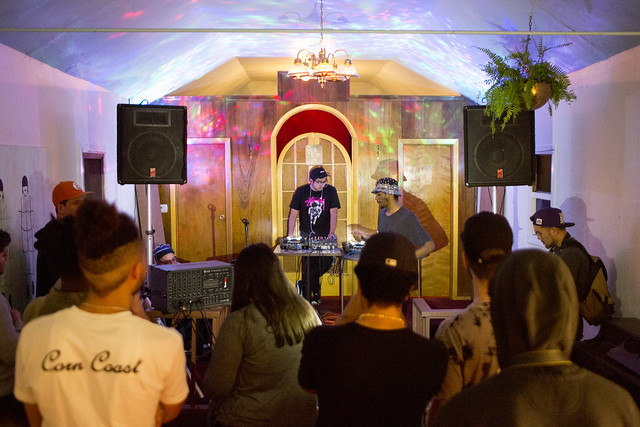
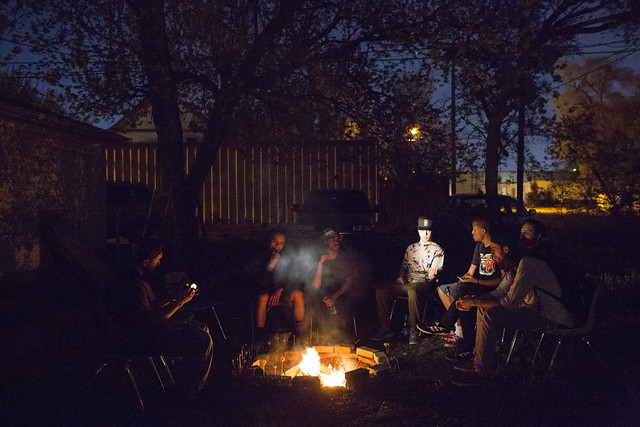
In that sense, GOODGOSPEL resembles equal parts amateur poetry reading and impassioned street sermon, certainly emboldened by the venue’s character, which, with cheap stained-glass windows, chancel and iconostasis, will likely never lose its quasi-spiritual trappings. The comparison between congregations brought together by religion and by music is inherent.
But to say that the GOODGOSPEL audience and Christians in Lincoln come together for essentially the same experience ignores an important reality. There are more than 100 churches in Lincoln. There is only one space reserved for foregrounding black hip-hop voices.




